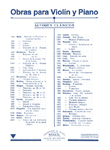WORKS
- Genre
-
Musical education
- Choir
- Counterpoint
- Dictation
- Direction
- Exam study manuals
- General music pedagogy
- Harmony
- Hearing
- Illustrations / Posters
- Improvisation / Sight reading
- Instrument methods
- Instrument pedagogy
- Instrumental study repertoire
- Instrumentation and orquestration
- Musical language
- Solfège
- Templates
- Theory and analysis
-
Incidental music
-
Lined paper
-
Flamenco
-
Religious music
-
Classical / contemporary
-
Modern music
-
Folk music / traditional
-
Musicology
-
Divulgation
-
Games and hobbies
-
Music therapy
-
Children / Youth
-
- Instruments
- Ensemble
- Difficulty level
- Period
- Genre
SOPORTE
Search
Find here: books, scores, composers, digital pieces, cd's
Best-selling works
Our classics

Newsletter
I wish to be informed of the news about your music
We have received your e-mail correctly
Multimedia
Don Quijote
El caballero de la triste figura
Piano a 4 manos
BASOMBA, DanielBASOMBA, DanielBASOMBA, DanielReg.: B.3642
21,90 €
P.V.P. (VAT included 4%)
Add to cart
- Ensemble: Duos: .
- Genres: Classical / contemporary: Chamber.
- Product format: Partitura
- Difficulty level: Intermediate-advanced
- Period: 2nd half S. XX - XXI
- Publishing house: Editorial Boileau
- Collection: Siglo XXI
- No. of pages: 56
- Measure: 31,00 x 23,00 cm
- Lenght: 16'38"
- ISMN: 979-0-3503-0888-8
- Available in digital: No
- Available for rent: No
This four-handed piano work was conceived as a kind of symphonic poem with a rhapsodical form. The structural balance comes out of the strong opposition between the assertively motorized passages and those with a euphoric lyricism. The programmatic discourse deals with the great Quixotic themes -madness, idealized love, the struggle between the individual and society, and death- interconnect not as a description of the facts of the novel, but rather as an attempt to sketch a portrait of the Knight of the Sad Countenance and his interior psychological conflict. The rhythmic element represents Quixote´s obstinate resistance and his heroic defence of his ideal when faced with the prosaic and mocking incomprehension of those around him. The melodic themes symbolize the retreat into oneself and the search for interior refuge. In keeping with the Germanic conception of Don Quixote which refused to accept his final, sad capitulation, I have, like Nietzsche and Thomas Mann, tried to give our hero´s story a victorious ending- one without knee-bending or lowering-of-the-gaze.
Daniel Basomba
Translation: Jeff Keefe
Contra el Mundo
Canción del Loco Enamorado
Burlesque
Muerte y Victoria








